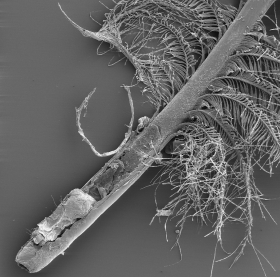
INTRODUCTION
Prostigmatans mites (Acari: Acariformes: Prostigmata) permanently associated with birds are po
tentially very species-rich groups supposedly in
cluding about 5000 species, but nearly 10 % (about 500
species) of these mites are recognized to date.
These mites occupy a great diversity of microhab
itats on the host body: skin, quills, intracutaneous
layers, and respiratory tract, and are very interest
ing in the global evolutionary sense as well as in
several parasitological aspects, including host-
parasite relationships.
This ecological group includes mites of five
families belonging to three phylogenetically dis
tant superfamilies: Cheyletidae, Harpirhynchidae,
and Syringophilidae of the superfamily Cheyletoidea, Cloacaridae (Cloacaroidea), and Ereynetidae (Tydeoidea).
Most prostigmatic inhabitants of bird are true
parasites feeding on live host tissues, but the ma
jority of cheyletids living in feather quills are
predators feeding on other quill-inhabiting mites
and thus should be considered as commensals or
even mutualists.
Taking into consideration the high specificity
of permanently parasitizing prostigmatans to avian
hosts and their non-random distribution on host
taxa,
data about these mites could be used for the valida
tion of host phylogeny and in deciphering of the
host biogeography. Such investigations were un
dertaken on various groups of symbionts, includ
ing acariform mites, and often showed a high level
of phylogenetic congruence between hosts and
symbionts. Although some investigations conducted on astigmatan mites did not reveal phylogenetically congruent pattern, they pro
vided valuable results for the host biogeography. At the same time,
as a taxonomically poorly studied group, the pros
tigmatans permanently associated with birds have
never been involved in this kind of investigations.
References: Kethley and Johnston 1975; Moss 1979; Mironov and Bochkov 2009; Fain 1994; Bochkov 2009; Skoracki 2011; Klassen 1992; Bochkov and OConnor 2005; Skoracki et al. 2012
